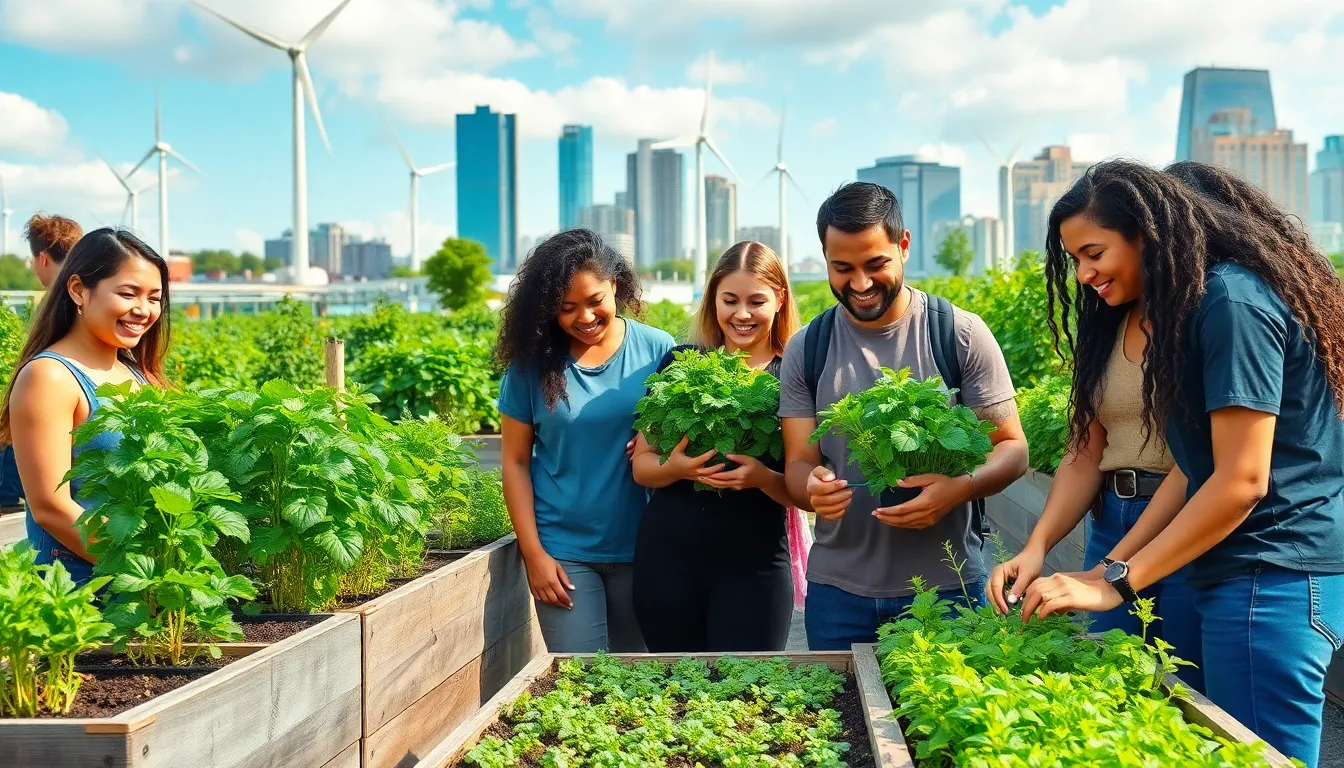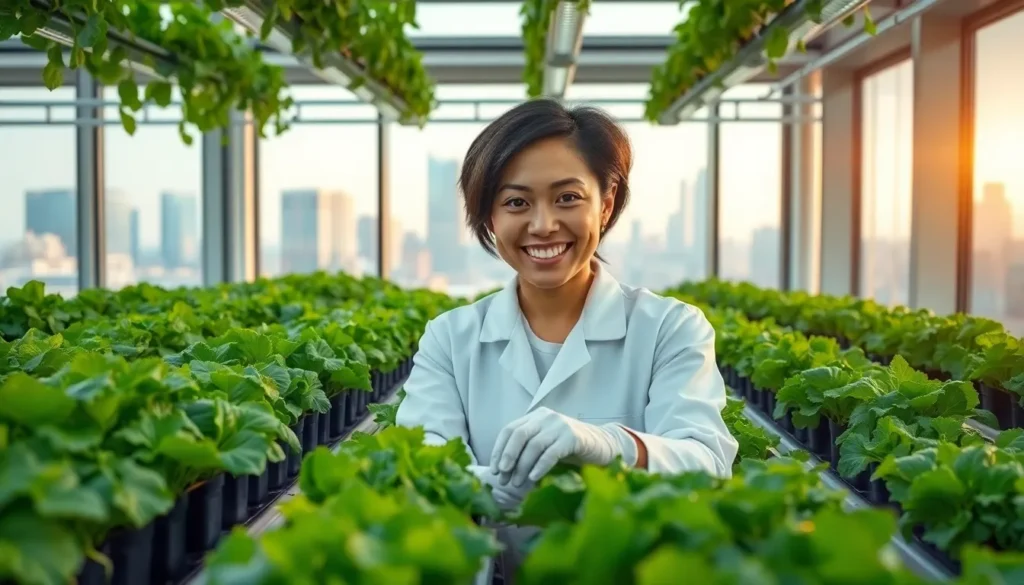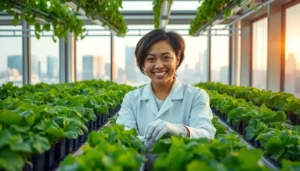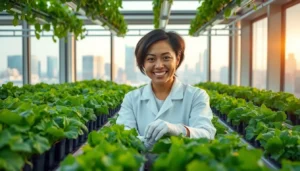Table of Contents
ToggleIn a world where food waste is as common as a soggy sandwich at a picnic, sustainable food technology swoops in like a superhero with a green cape. It’s not just about saving the planet; it’s about making sure that the next generation doesn’t have to survive on kale chips and regret. With innovative solutions popping up faster than you can say “organic quinoa,” this tech is transforming the way we grow, process, and consume food.
Overview of Sustainable Food Technology
Sustainable food technology encompasses innovative practices aimed at reducing environmental impact while enhancing food security. This technology addresses critical issues such as food waste, resource depletion, and climate change through advanced solutions. Researchers focus on various aspects, including food production methods, processing techniques, and distribution systems.
Innovative approaches like vertical farming leverage urban spaces for efficient crop production. These farms use hydroponics or aeroponics to grow food without soil, significantly minimizing water usage. Additionally, plant-based alternatives have gained traction, providing options that reduce reliance on animal agriculture.
Food preservation technologies, such as smart packaging, help extend shelf life and reduce waste. By incorporating sensors, these packages can monitor freshness and quality, alerting consumers when food is no longer suitable for consumption. Sustainable practices also include regenerative agriculture, which promotes healthy soil and biodiversity.
Consumer engagement plays a vital role in the success of sustainable food technology. Education initiatives help consumers understand the benefits of choosing sustainable options. Food companies are increasingly transparent about their supply chains, allowing consumers to make informed choices.
Government policies are starting to support sustainability efforts within the food sector. Financial incentives encourage farmers to adopt eco-friendly practices. These measures help create an environment where sustainable food technology can thrive and innovate further.
Through the integration of these technologies, food systems move toward a more sustainable future. Enhanced resource management, coupled with innovative practices, contributes to better food availability and health outcomes. Sustainable food technology represents a forward-thinking approach to ensuring a viable food supply for generations to come.
Benefits of Sustainable Food Technology

Sustainable food technology offers numerous advantages for society and the environment. It promotes efficient resource use and improves overall health by transforming food systems.
Environmental Impact
Sustainable food technology significantly reduces negative effects on the environment. It enhances resource management by minimizing water usage through techniques like vertical farming. Efficient practices lower greenhouse gas emissions, contributing to climate change mitigation. Smart packaging technologies keep food fresh longer, which helps decrease food waste. Additionally, the rise of plant-based alternatives lessens reliance on resource-intensive animal farming. This shift aids in conserving biodiversity, promoting overall ecosystem health.
Economic Advantages
Economic benefits of sustainable food technology are substantial. Businesses adopting eco-friendly practices often see cost savings through reduced waste and lower energy consumption. Investing in innovative processing methods can lead to increased productivity and profitability. Consumers increasingly prefer sustainable products, opening up new market opportunities. Government incentives for sustainable practices promote growth in green technology sectors. Job creation in areas like urban agriculture fosters economic stability and resilience in communities.
Innovations in Sustainable Food Technology
Innovative approaches in sustainable food technology address pressing challenges in food production and environmental impact. These advancements reshape agricultural practices and food consumption.
Vertical Farming
Vertical farming transforms urban agriculture by utilizing limited space efficiently. This method employs stacked layers to cultivate crops, significantly reducing the need for arable land. Hydroponic systems within these farms maximize water use efficiency, using up to 90% less water than traditional farming. Fresh produce can be grown year-round, shortening supply chains and minimizing perishable waste. Additionally, vertical farms often operate with renewable energy sources, decreasing carbon footprints. As urban populations grow, this technology provides a sustainable solution to food production and local food security.
Lab-Grown Meat
Lab-grown meat offers a revolutionary alternative to conventional meat production. Cultured meat is created by cultivating animal cells in a controlled environment, eliminating the need for livestock farming. This process reduces greenhouse gas emissions by up to 96% compared to traditional meat production methods. Water usage also decreases dramatically, using 45% less water than conventional practices. By reducing land use, lab-grown meat helps preserve natural habitats and biodiversity. As consumer awareness of environmental issues increases, this innovative food technology presents a viable path toward sustainable meat consumption and addresses ethical concerns related to animal welfare.
Challenges in Implementing Sustainable Food Technology
Implementing sustainable food technology presents several challenges to overcome. These challenges significantly impact the overall effectiveness of transitioning to more sustainable food systems.
Cost Concerns
Cost remains a primary hurdle for businesses adopting sustainable food technologies. Traditional farming methods often appear more affordable than innovative practices like vertical farming or lab-grown meat. Initial investment frequently deters smaller farms from incorporating advanced technologies. Long-term savings through reduced waste and lowered resource consumption can offset upfront expenses. Financial incentives offered by governments can provide necessary support for these transitions. Many businesses find that as they gain experience with sustainable methods, operational costs decrease, making the investment worthwhile.
Consumer Acceptance
Consumer acceptance poses a significant challenge in the adoption of sustainable food technologies. Many consumers remain hesitant to try alternatives like lab-grown meat or plant-based products due to perceived unfamiliarity. Education initiatives play a crucial role in reshaping consumer perceptions and increasing understanding of the benefits associated with these technologies. Establishing trust through transparency and engaging marketing strategies can enhance consumer acceptance. As consumers become more aware of sustainability issues, their preferences shift towards eco-friendly options, increasing demand for sustainable products. Fostering this awareness can bridge the gap between innovative practices and consumer behavior.
Future Trends in Sustainable Food Technology
Emerging advancements in sustainable food technology significantly reshape food systems. Vertical farming utilizes controlled environments to enhance crop yields while minimizing resource use. Systematic innovations in lab-grown meat production reduce reliance on traditional livestock farming, drastically cutting greenhouse gas emissions.
Consumer preference for plant-based foods drives the growth of alternative proteins. Experts predict that by 2030, the market for plant-based alternatives may surpass $74 billion. Technologies like precision agriculture are gaining traction, enabling farmers to monitor and optimize crop health through data analytics.
Smart packaging solutions are increasingly vital for maintaining freshness and prolonging shelf life. These technologies can alert consumers about food quality, reducing waste while enhancing overall consumer experience. Blockchain technology is also emerging, providing transparency in food supply chains. This transparency builds trust between consumers and producers, ensuring accountability in sustainable practices.
Collaborations between startups and traditional agricultural firms are crucial. These partnerships allow for the exchange of ideas and scaling of successful sustainable solutions. Government investments and incentives will likely increase as sustainability becomes a priority across food sectors.
Education initiatives are becoming more prominent, equipping consumers with knowledge about sustainable practices. Increased awareness leads to a greater acceptance of alternative food technologies. Furthermore, local food systems are gaining attention as a method of reducing carbon footprints while supporting local economies.
Exciting developments in sustainable food technology promise enhanced ecological balance and improved public health. The focus remains on creating resilient food systems that contribute to economic stability and resource management for future generations.
Sustainable food technology stands as a beacon of hope in addressing pressing global challenges. By integrating innovative practices and consumer engagement, it paves the way for a more resilient and efficient food system. The ongoing advancements in vertical farming, lab-grown meat, and smart packaging not only reduce waste but also enhance food security.
As society moves towards embracing these technologies, collaboration between stakeholders will be crucial in overcoming barriers and fostering acceptance. With continued investment and education, sustainable food technology can transform agricultural practices and consumption patterns, ultimately benefiting both the planet and future generations. The journey toward sustainability is just beginning, and the potential for positive change is immense.







